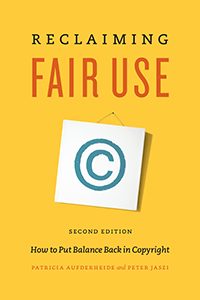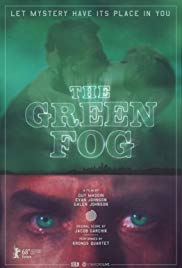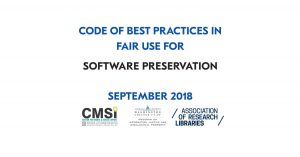 The second edition of Reclaiming Fair Use: How to Put Balance Back in Copyright (University of Chicago Press, 2018) documents a decade of success in changing creative practice that took even the authors by surprise.
The second edition of Reclaiming Fair Use: How to Put Balance Back in Copyright (University of Chicago Press, 2018) documents a decade of success in changing creative practice that took even the authors by surprise.
When I first met Peter Jaszi, my co-author, I hadn’t given more than a passing thought to the copyright doctrine of fair use, and I was in good company among my communication-scholar peers.
After 15 years of joint work with him to make fair use more useable for a range of professionals, I’ve come to see fair use as the unsung hero of copyright policy—small, unpretentious, sturdy, persistent and capable of remarkable achievements. And I’ve come to see the law as a reality between the page and the act—one that most importantly lives inside people’s heads.
You use it every day.
Fair use, of course, is the U.S. right (and it is a right, written as such into the Copyright Act) to use appropriate amounts of other people’s copyrighted work for a transformative purpose–that is, not a purpose currently part of the market for that copyrighted work. Fair use is routinely used every day. Journalists use it to quote each others’ work, comments of their interview sources, and documents. Search engines use it to make temporary copies of copyrighted work in order to fulfill your search request. Academics use it to quote other scholars and use illustrations in their work.
Yes, you’ve been using fair use all your life.
But if I ask you to define it, or whether you’d use it, you’d probably be scared to do so. Because people, including maybe your grade school teacher and certainly all the media companies that understandably hate digital copying, keep telling you copying is a bad, illegal and possibly immoral act.
Creative, Generative, and Innovative.
Some copying, though, is downright creative, generative and even innovative. That’s what we learned from watching how creative practice changes when people learn their rights.
We tell the stories of what people could create, once they knew the law in the second edition of Reclaiming Fair Use. We wrote it after ten years of steady and uncontroversial success in expanding access to fair use. The first edition was a story of hope. The second edition is a story of proven success, one where academic research meets public action.
“I could not have imagined,” said Diana Holtzberg, a leading producer of documentary films who is one of the godmothers of the fair use movement, “that we would have come so far so fast.”
Critical Hipsterism.

Artisanal plungers from Re Made Co
Take Rebekah Modrak, an art professor at University of Michigan. Her work spoofed the hipster site Best Made Co, whose TriBeCa site offers spectacularly overpriced objects inappropriate for urban life. She invented a parody company Re Made Co, and created a side-by-side video of Best Made’s video ad for an artisanal axe and Re Made’s version promoting…an artisanal plunger.
After getting a cease-and-desist letter from Best Made, her university’s lawyers assured her she could treat the cease-and-desist letter as the nuisance-nastygram it was.
She then wrote about her experience for a Routledge academic journal, Consumption Markets and Culture. She included an illustration from her video, featuring a side-by-side image of the original Best Made ad and her own parody. At first, the Routledge editors told her that although she would have to get permission for the Best Made side of the artwork—in spite of the fact that the article recounted why she did not need permission. But then she took the Code of Best Practices in Fair Use for the Visual Arts, which we had facilitated at the request of her professional association the College Art Association, to the editors. The journal then published the work with illustrations without further ado.
Being able to employ fair use, Modrak said, “strengthened my own scholarship. I thought that Routledge would come back and say, ‘Sorry, we’re a UK publisher; fair use isn’t applicable here,’ but instead, we were able to inform Routledge’s practice! How awesome is that!”
Filmmakers flex fair use.
 In 2017, Canadian filmmaker Guy Maddin, whose work regularly features re-editing of existing work to create new meaning, was commissioned by the San Francisco Film Festival to make a city symphony-style film to close out the festival. (Fair use applies in the country where you are working, and it applies to any material you may use there.) The resulting “Green Fog” was a retelling of the Hitchcock film Vertigo exclusively using images from San Francisco in other films and television. He used everything from actuality shots from pre-1906 earthquake San Francisco to the TV series The Streets of San Francisco—all under the fair use doctrine.
In 2017, Canadian filmmaker Guy Maddin, whose work regularly features re-editing of existing work to create new meaning, was commissioned by the San Francisco Film Festival to make a city symphony-style film to close out the festival. (Fair use applies in the country where you are working, and it applies to any material you may use there.) The resulting “Green Fog” was a retelling of the Hitchcock film Vertigo exclusively using images from San Francisco in other films and television. He used everything from actuality shots from pre-1906 earthquake San Francisco to the TV series The Streets of San Francisco—all under the fair use doctrine.
Maddin follows in the tradition not only of the great city symphony filmmakers of the 1920s and 1930s but also more recently of Thom Anderson, an artist in experimental film whose feature Los Angeles Plays Itself, composed entirely of film clips and images, got rave reviews in 2004. But it was stalled in distribution until the shift in documentary practice around fair use, triggered by creating The Documentary Filmmakers Statement of Best Practices in Fair Use, caught up with it almost a decade later.
Oh, the librarians and archivists.
Librarians and archivists have long been champions of fair use. In fact, fair use may never have codified in the 1976 Copyright Act reform if it weren’t for librarians. But even so, many of them have been intimidated out of employing their fair use rights over the years. Creating codes of best practices in fair use has changed librarians’ choices, and their actions.
They came to understand that even the act of curating work can be transformative and entirely within the law. Instantly, practices began to change. At the University of California, Berkeley, a diverse and largely unlabeled collection of historic photographs of the region were uploaded to a library website. Information flooded in as people identified landmarks and even authors. (The library made it easy to send complaints, but so far they have only received praise and information useful for metatagging.) The University of Tennessee at Knoxville made public on its website a historic collection of tourist postcards from the Great Smoky Mountains—a collection of interest to historians, cultural studies scholars, geographers and more.
At the University of Colorado-Boulder, the university decided it would be uncontroversial to copy VHS cassettes to digital-file formats if no commercial version was available. At Texas A&M, University of California, Santa Barbara, and Harvard, new standards documents helped faculty understand their rights better.
The University of California, Los Angeles library opened up a digital portal to its video news collection, Broadcast NewsScape. It made available some 200,000 and counting captioned TV programs from around the world, from 2005 onward, to students, faculty and staff of UCLA. Oberlin College launched SongWorks for Children–700 videos of children learning through singing songs (many copyrighted)—open to anyone on the Internet. The New York Public Library digitized its vast archive on the New York World’s Fair of 1939, and created an app to allow patrons to search the digital archive on their phones.
And every one of these actions changed what the law means in practice, by the “I think I can” logic.
And now, software preservation.
Every time we think we’ve completed this work, new communities surprise us. The latest is software preservationists. Software is now the paper on which culture is created and recorded. But software goes obsolete in the wink of an eye—hope you don’t have anything you’d like to see on Flash or Java applets. The only people in charge of preserving it are under-resourced archivists scattered around the world.
 Whenever they try to do basic parts of their job, like making a preservation copy, they face copyright challenges. They face them again when they have to decide if anyone can access the work they’re preserving, and whether they can do the equivalent of Inter-Library Loan with their software.
Whenever they try to do basic parts of their job, like making a preservation copy, they face copyright challenges. They face them again when they have to decide if anyone can access the work they’re preserving, and whether they can do the equivalent of Inter-Library Loan with their software.
Fair use cuts through the problems elegantly, and without a whiff of harm to the companies that created the software. We’ve worked with the Software Preservation Network and key collecting institutions to create a Code of Best Practices in Software Preservation.
And then….let’s find out what happens. I can’t wait.
